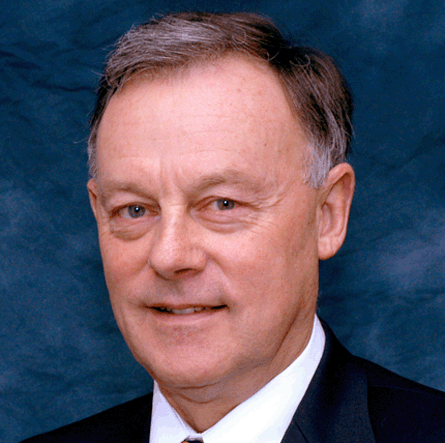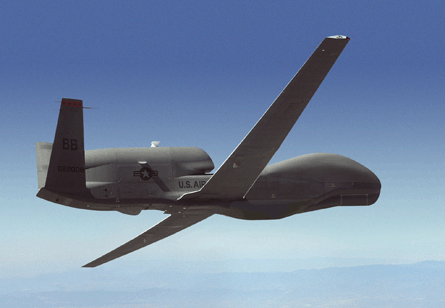Bob Mitchell has been called the father of the Global Hawk, but the world's first high-altitude, long-endurance autonomous unmanned air vehicle is just one of a series of unmanned technologies the vice president of Northrop Grumman's Aerospace Systems business has helped bring to reality.
The president of Teledyne Ryan Aeronautical before its acquisition 10 years ago by Northrop Grumman, Mitchell led the team that developed the Global Hawk, the most iconic and now battle-proven UAV. He later brought it to market - along with the Fire Scout helicopter-based vertical take-off and landing UAV - at his new employer.
 |
|---|
© Northrop Grumman |
His enormous contribution to the development of unmanned systems "goes beyond just a focus," enthuses a colleague: "It is a vision for bringing unmanned systems to the mainstream." The widespread respect he commands among his colleagues and the wider aerospace community is the reason Mitchell won the popular vote for Leader of the Year in the Flightglobal Achievement Awards, presented at the show last night. He beat off stiff competition from Akbar Al Baker of Qatar Airways, Dr Mark Pierotti of Abu Dhabi business aviation start-up Al Jaber Aviation and Rolls-Royce chief executive Sir John Rose.
Back in the 1990s - before 9/11 and the so-called war on terror - UAVs were still very much seen as a technology of the future, at least as far as the US military and industry were concerned. Although Ryan had pioneered UAVs with the Firebee KDA-1 back in the 1950s, and the Vietnam era had seen further developments, UAVs were not seen as a priority at a time when the Pentagon focus was on Cold War stealth fighters and long-range bombers and spyplanes.
The technology came back into vogue in the 1990s with the end of the Cold War and a new emphasis on the sort of threats that began to emerge from parts of the Middle East and campaigns such as the NATO action against Serbia. The Israelis had long been successful exponents of the technology, and the US government and its various agencies began to fast-track funding for developments. One such competition led to Global Hawk, which beat off competition from the Lockheed Martin/Boeing Darkstar to win a Defence Advanced Research Projects Agency contract.
 |
|---|
© Northrop Grumman |
Since its first overseas contingency operation in Afghanistan in 2001, Global Hawk has now logged over 31,000 flight hours for the US Air Force and US Navy, with more than three-quarters of them - more than 1,100 missions - in theatre. Able to fly at altitudes of more than 60,000ft for more than 32 hours, the UAV can image an area the size of the state of Illinois in one mission.
Mitchell also led the team that developed the MQ-8 Firescout from a Schweizer helicopter design, turning it into an operational system and offering it to the US Navy virtually as an off-the-shelf product aimed at providing mine detection and surveillance from ships.
The Flightglobal Leader of the Year award is not the only accolade Mitchell has won this year. In August, the Association for Unmanned Vehicle Systems International (AUVSI) recognised his "pivotal role in the advancement of unmanned systems", honouring him with the Al Aube Outstanding Contributor Award in recognition of his "visionary leadership and dedication towards the promotion and execution of unmanned technologies".
At August's award ceremony, AUVSI Foundation executive Director Daryl Davidson paid tribute to his achievements: "His contributions go beyond just a focus, it is a vision shared across the industry for bringing unmanned systems into the mainstream. For all intents and purposes, Mitchell is the founding father of Northrop Grumman's core competencies in the technology leadership in developing unmanned systems. His knowledge, vision and experience have been used on a multitude of captures and campaigns."
Recognition indeed for the man who helped transform the way the US military fights its wars and propelled a technology that had its sceptics as an effective combat tool into the mainstream.
FINALISTS
- Akbar Al Baker
He may be one of the few airline bosses still buying aircraft, but executives from Seattle and Toulouse upset Akbar Al Baker at their peril. The Qatar Airways chief executive made headlines at the Paris air show in June with an order for 24 A320s and an uncompromising warning to Boeing that he would "walk away" from a 60-aircraft 787 order if the manufacturer did not resolve delivery issues. The forthrightness is typical of Al Baker, who with determination, vision and leadership skills has overseen the growth of a tiny Gulf flag-carrier to a global brand that sets the bar in customer service and has helped put Qatar on the map.
- Mark Pierotti
The Gulf region has seen a flurry of business aviation start-ups, but one of the most prestigious and promising is AJA Private Jets, part of the Abu Dhabi-based Al Jaber industrial group. Chief operating officer Dr Mark Pierotti has spearheaded the venture, which launched commercial services in June with an Embraer Legacy 600 flight to Sharm-El-Sheikh, Egypt and Paris. With 20 more aircraft on order, comprising A318- and A319-based Airbus corporate jets and Embraer Lineages and Legacys, Pierotti has steered a business plan which has taken account of the downturn and included diversification into support services such as third-party maintenance.
- Sir John Rose
As he approaches retirement after 13 years as Rolls-Royce chief executive, Sir John Rose will hand his successor a rock-solid business, with an enviable product line-up spearheaded by the Trent family, healthy diversification between its commercial and defence divisions and half its revenues coming from services. The UK engine maker continued its robust financial performance in the first half of 2009, with a record order book and increased profits and turnover. Although the first R-R boss who is not an engineer (his background is aircraft finance), Rose has enthusiastically lobbied the UK government to do more to promote engineering careers to youngsters.
Source: Flight Daily News
















